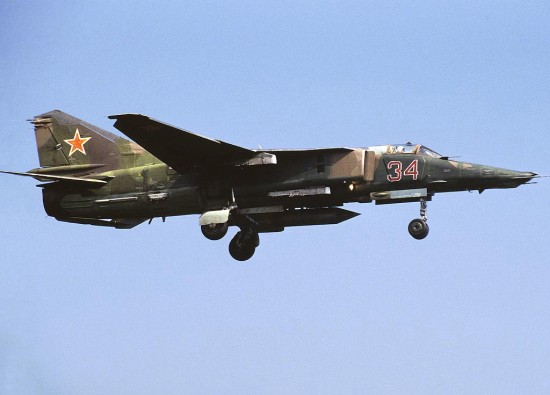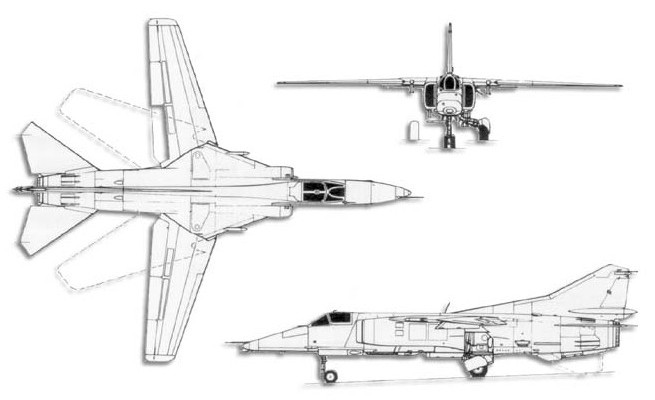|
||||||||||
|
|
||||||||||
|
||||||||||
|
|
||||||||||
 - -
 - -
|
|

|
Mikoyan Gurevich MiG-27 ASCC codename: Flogger Ground Attack Fighter |
|
DESCRIPTION:
The success of later MiG-23 attack variants led to the development of a dedicated ground attack aircraft based on the MiG-23 design. This new aircraft was designated as the MiG-27. Though using the same basic airframe as the MiG-23, the MiG-27 has a different engine, a longer nose, a new cockpit, different landing gear for rough-field operations, a navigation/attack system tailored to the ground attack mission, and lacks a radar. Though considered to be a new aircraft, there have been numerous cross-overs in later models of the MiG-23 and MiG-27 family such that the final versions built were mostly hybrid MiG-23BM/BN attack fighters. Production of the MiG-27 in the Soviet Union ended in the mid-1980s, though license manufacture in India may have lasted longer. Both the MiG-23 and MiG-27 were largely phased out of Russian service by the mid-1990s, but the type remains in use with export customers. Primary users currently are India and Sri Lanka, where the MiG-27 was particularly useful in ending the Tamil civil war.
Last modified 17 March 2012
|
|
| HISTORY: | |
| First Flight | 20 August 1970 |
| Service Entry | 1975 |
| Retirement |
(Russia) 1994
|
| CREW: |
one: pilot
|
|
ESTIMATED COST:
|
unknown
|
| AIRFOIL SECTIONS: | |
| Wing Root | TsAGI SR-12S (6.5%) |
| Wing Tip |
TsAGI SR-12S (5.5%)
|
| DIMENSIONS: | |
| Length | 56.02 ft (17.076 m) |
| Wingspan |
unswept: 45.83 ft (13.965 m) swept: 25.54 ft (7.779 m) |
| Height | 16.42 ft (5.00 m) |
| Wing Area | 293 ft² (27.3 m²) |
|
Canard Area
|
not applicable
|
| WEIGHTS: | |
| Empty | 26,250 lb (11,910 kg) |
| Normal Takeoff | 34,170 lb (15,500 kg) |
| Max Takeoff | 44,750 lb (20,300 kg) |
| Fuel Capacity |
internal: unknown external: unknown |
|
Max Payload
|
8,820 lb (4,000 kg)
|
| PROPULSION: | |
| Powerplant | one Soyuz/ Khachaturov R-29B-300 afterburning turbojet |
| Thrust |
17,625 lb (78.40 kN) 25,335 lb (112.7 kN) with afterburner |
| PERFORMANCE: | |
| Max Level Speed |
at altitude: 1,170 mph (1,885 km/h) at 26,250 ft (8,000 m), Mach 1.5 at sea level: 840 mph (1,335 km/h), Mach 1.1 |
| Initial Climb Rate | 39,370 ft (12,000 m) / min |
| Service Ceiling | 45,900 ft (14,000 m) |
| Range |
typical: 415 nm (770 km) ferry: 1,350 nm (2,500 km) |
| g-Limits |
+6
|
| ARMAMENT: | |
| Gun | one 23-mm GSh-23L or 30-mm GSh-6-30 two-barrel cannon (260 rds) |
| Stations | 5 external hardpoints |
| Air-to-Air Missile | K-13/AA-2 Atoll, R-60/AA-8 Aphid |
| Air-to-Surface Missile | AS-7 Kerry, AS-14 Kledge, Kh-29 |
| Bomb | FAB-250, FAB-500 conventional bombs, nuclear bombs, cluster bombs |
| Other |
rocket pods, ECM pods
|
| KNOWN VARIANTS: | |
| MiG-23B 'Flogger-F' | First MiG-23 attack variant that later led to the MiG-27 series; 24 production models built |
| MiG-23BK 'Flogger-H' | Ground attack fighter based on the MiG-23B sold for export to Warsaw Pact nations |
| MiG-23BN 'Flogger-H' | Primarily an export model similar to the MiG-23B except with a different engine, an improved wing design, and new avionics; 624 built ending in 1985 |
| MiG-23BM 'Flogger-D' | Upgrade to the MiG-23BK to replace the ground attack sight system and introduce a digital attack computer, became the basis of the MiG-27 family and several MiG-23BM test aircraft introduced increasingly radical changes from the original fighter series |
| MiG-27M 'Flogger-J' | Significantly more capable attack model based on the MiG-23BK with a new gun, improved electronic countermeasures, and a nav/attack system allowing automatic flight control, weapons release and gun control, and automatic flight to the target using preprogrammed data; 200 built from 1978 to 1983 plus 160 license-built by India |
| MiG-27D | MiG-23BM airframes upgraded to the MiG-27M standard; 305 converted |
| MiG-27K 'Flogger-J2' | Similar to the MiG-27M but incorporating a laser designator and compatibility with TV-guided electro-optical weapons, the final version used by the Soviet Union; approximately 200 built |
|
MiG-27L or MiG-27M Bahadur |
Export model sold to India based on the MiG-27M and largely identical except with a different window for the infrared search and track camera; about 150 assembled in India from kits or built under license |
| MiG-27H | Upgrade applied by India to its MiG-27L fleet consisting of new French avionics including glass cockpit displays, compatibility with GPS and GLONASS, improved communications systems, inproved inertial navigation, electronic warfare equipment, and installation of a radar to provide anti-ship capability; some 140-180 modified |
| MiG-27J |
Export model
|
| KNOWN COMBAT RECORD: |
Afghanistan War (Soviet Union, 1979-1989) Iran-Iraq War (Iraq, 1980-1988) Iraq - Operation Desert Storm (Iraq, 1991) Iraq - Operation Desert Fox (Iraq, 1998) Kargil War (India, 1999) Tamil conflict (Sri Lanka, 2000-2009) |
| KNOWN OPERATORS: |
Cuba, Defensa Antiaerea y Fuerza Aérea Revolucionaria (Anti-Aircraft Defense and Revolutionary Air Force) Georgia (Georgian Air Force) India, Bharatiya Vayu Sena (Indian Air Force) Iran (Islamic Republic of Iran Air Force) Kazakhstan (Kazakhstan Air Force) Russia, Voyenno Vozdushniye Sili (Russian Air Force) Sri Lanka (Sri Lankan National Air Force) Ukraine, Viys'kovo-Povitriani Syly Ukrayiny (Ukraine Military Air Forces) Union of Soviet Socialist Republics, Voyenno Vozdushniye Sili (Soviet Air Force) |
|
3-VIEW SCHEMATIC:

|
|
SOURCES:
|
|


|
Aircraft | Design | Ask Us | Shop | Search |

|
|
| About Us | Contact Us | Copyright © 1997-2023 | |||
|
|
|||